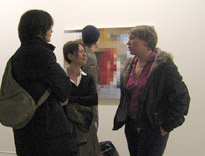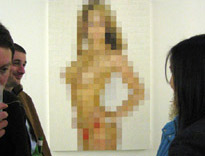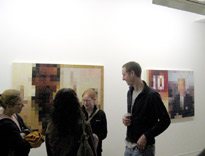| Contact |
 |
Artifactuality, Leeds City Art Gallery, 2006 Statement displayed in the gallery: The relationship between representation and reality has been a subject for debate since the first man-made images. Now that advances in technology make images appear increasingly lifelike the intensity of this debate has risen. Philosophers such as Jean Baudrillard have even claimed that our immersion in the world of images means that a sense of reality itself has become inaccessible to us. Another theorist, Jacques Derrida, uses the term artifactuality to describe the process whereby the media creates what is seen as reality, rather than simply reflecting the real world. This field of study forms the backdrop for a series of paintings that replicate contemporary digital images. The choice of subjects is motivated by the question: why does the media tend to portray things as it does and in whose interest? For example it is often argued that the media simply meets the demands of its audience for coverage of football or pictures of glamorous women but such demands are partly created by the media who use these topics to market their product. Images are also powerful tools in establishing and perpetuating particular viewpoints, such as the dependability of a political figure or the desirability of a consumer object. Analysing how such images are deployed and received can only help the understanding of how the media affects us. Each painting is made up from squares, or pixels, of colour that are mixed and applied by hand to correspond to the original image as closely as possible. Individual pixels in digital photographs or on screen usually appear to form a seamless image but here this mechanism is exaggerated so that it becomes difficult to see what the painting represents. This is done with the intention of emphasising the process of mediation that always separates reality and representation not only in painting but in photography and film as well. |
|
 |
||
 |